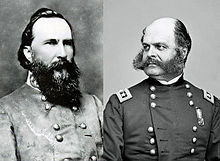| Knoxville campaign | |||||
|---|---|---|---|---|---|
| Part of the American Civil War | |||||
 James Longstreet and Ambrose Burnside, principal commanders of the Knoxville campaign | |||||
| |||||
| Belligerents | |||||
|
|
| ||||
| Commanders and leaders | |||||
| Ambrose Burnside | James Longstreet | ||||
| Units involved | |||||
|
| |||||
The Knoxville campaign[1] was a series of American Civil War battles and maneuvers in East Tennessee, United States, during the fall of 1863, designed to secure control of the city of Knoxville and with it the railroad that linked the Confederacy east and west, and position the First Corps under Lt. Gen. James Longstreet for return to the Army of Northern Virginia. Union Army forces under Maj. Gen. Ambrose Burnside occupied Knoxville, Tennessee, and Confederate States Army forces under Longstreet were detached from Gen. Braxton Bragg's Army of Tennessee at Chattanooga to prevent Burnside's reinforcement of the besieged Federal forces there. Ultimately, Longstreet's Siege of Knoxville ended when Union Maj. Gen. William Tecumseh Sherman led elements of the Army of the Tennessee and other troops to Burnside's relief after Union troops had broken the Confederate siege of Chattanooga. Although Longstreet was one of Gen. Robert E. Lee's best corps commanders in the East in the Army of Northern Virginia, he was unsuccessful in his attempt to penetrate the Knoxville defenses and take the city.
- ^ The U.S. National Park Service classifies the five battles in this article into two campaigns: the East Tennessee campaign (Blountsville and Blue Springs) and Longstreet's Knoxville campaign (Campbell's Station, Fort Sanders, Bean's Station).